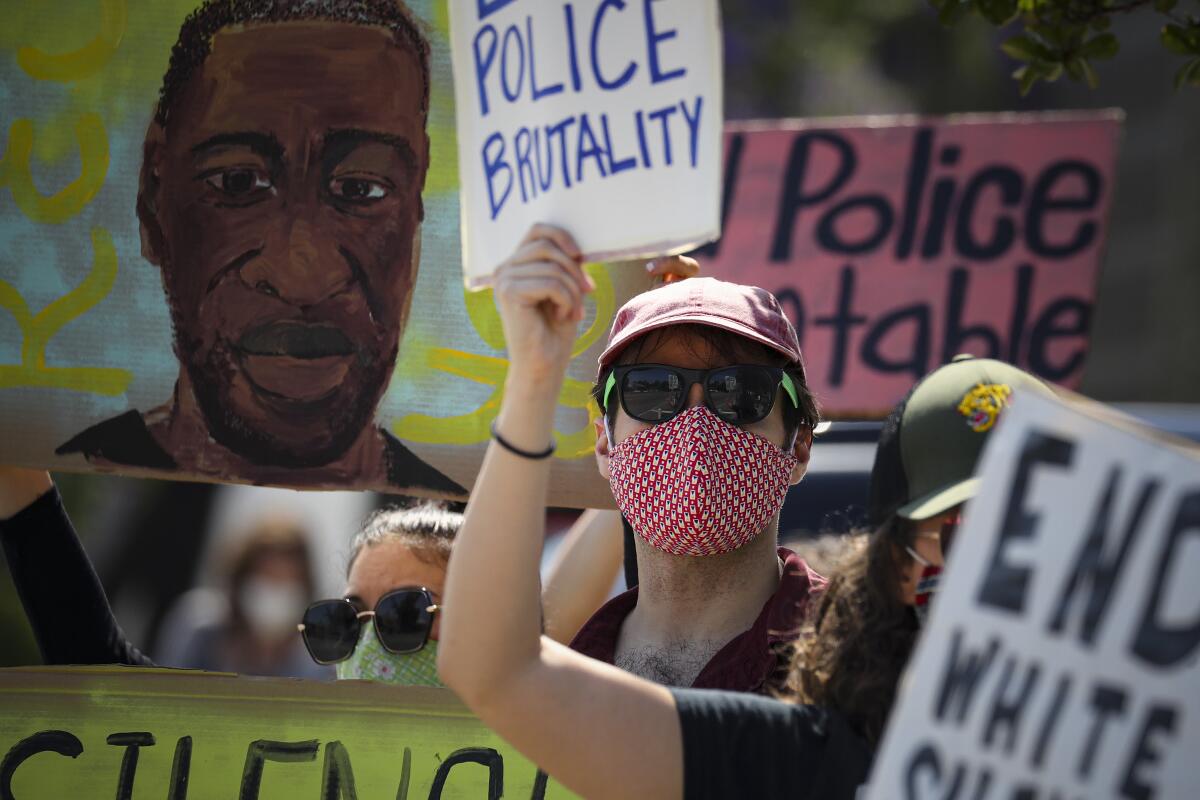Latinx Files: More Latinx families are raising their voices against police brutality

On the night of June 2, 2020, Sean Monterrosa was shot and killed in the parking lot of a Walgreens in Vallejo, Calif., a city just north of San Francisco. Police say they mistook a hammer — Monterrosa was a cement mason and was learning carpentry — for a gun.
It’s been more than a year since the death of Monterrosa, and his two sisters Ashley and Michelle have spent much of that time demanding answers. Their ongoing fight was the subject of a story written by CNN’s Nicole Chavez that took a broader look at how police brutality affects the Latinx community.
According to the Washington Post’s Fatal Force database, 1,061 Latinx people have been shot and killed by police since 2015. Since 2018, 67% of all people shot and killed by the Los Angeles Police Department were Latinx, a disproportionately high figure given that Latinxs make up just about half of L.A. County’s total population.
“We want justice for Sean, and we want that justice to mean that this can’t happen to anyone anywhere else,” said Ashley Monterrosa at a news conference outside San Francisco’s City Hall.
“And best believe we’re pushing to be the last family affected by the Vallejo Police Department.”
The Latinx experience chronicled
Get the Latinx Files newsletter for stories that capture the multitudes within our communities.
You may occasionally receive promotional content from the Los Angeles Times.
Beyond just protesting, the sisters have been applying pressure on the legislative front, including testifying in favor of California’s proposed SB 2, which would make it easier to decertify officers who commit serious misconduct. (Anita Chabria, who covers California state politics for The Times, has this breakdown of SB 2 and the challenges the bill faces.)
“We can always hit the streets … we can protest but it’s meaningless if we’re not working on anything on the back end to hold people in office accountable,” Ashley Monterrosa told CNN.
The Monterrosa sisters are the latest example of young Latinxs speaking out against police brutality. My colleague Brittny Mejia wrote about this very subject last year after the nationwide protests over the murder of George Floyd. It’s a promising trend, one that gives me hope that true police reform and accountability might one day become a reality.
But we are not there. This isn’t the first time I’ve written about police brutality in this space and it certainly won’t be the last. There is more work to be done. Thankfully, people like the Monterrosa sisters are stepping up to the challenge.
Consider subscribing to the Los Angeles Times
Your support helps us deliver the news that matters most. Become a subscriber.
Meet our Latinx staff: David Carrillo Peñaloza
The Los Angeles Times employs more than 100 Latinx journalists. One of the goals of this newsletter is for you to meet them all. This week, we highlight David Carrillo Peñaloza, a multiplatform editor.
This week, I met with our hermanos and hermanas from our sister paper, the San Diego Union-Tribune, over Zoom. Lilia O’Hara, the editor of SDUT en Español, invited me to talk about The Times’ new online section, Latino Life.
I was part of the team that launched Latino Life at the start of this month. It’s an effort to highlight our coverage of the Latino community. It’s a place where you can find all the great stories, photos, videos, newsletters, podcasts and special projects The Times produces on Latinos.
With 100-plus Latino journalists, we can tell our stories in English and Spanish. Stories on Latinos — and by Latinos.
We’re everywhere. Latinos account for nearly half of Los Angeles County residents and about 40% of California’s population. Latino Life is here to showcase our stories, our triumphs, our struggles and our everyday experiences. (Our hermanos and hermanas in San Diego also do a great job with their Latino coverage, which you can check out here.)
I learned to read because of the Los Angeles Times. At breakfast each morning before school, it was my job to read the newspaper to my family. My Mexican parents did not read or speak English. They relied on me to inform them of the current events, which I translated into Spanish.
I felt like I was delivering the news. I feel the same way today as a multiplatform editor at The Times.
Things we read this week that we think you should read

— My Los Angeles Times en Español colleague Soudi Jiménez wrote this Column One profile on José Zelaya, who escaped El Salvador during the country’s civil war and became the “only native Salvadoran graphic artist and character designer working for Disney Television Animation.” It’s a truly moving account filled with heartbreak and hope, but the part that stuck out to me the most was that Zelaya was the one who created the “Recess” character of Ashley Spinelli.
— The homie Beto Durán, who previously hosted The Times’ sports podcast “Arrive Early, Leave Late,” did this inspiring segment for CBS Los Angeles on David Lopez Jr., a student who overcame a double amputation to achieve his dream of playing for his school’s basketball team.
— On Saturday the Los Angeles Football Club had a home game with a full capacity crowd for the first time in more than a year. Noticeably absent from the stands was Mauricio “Mo” Fascio, one of the founders of the 3252, the team’s supporter group. Fascio died in March of COVID-19. Sports columnist Bill Plaschke wrote this touching story on a man who meant so much to the soccer club and its fans. Video journalist and noted biscuit enthusiast Mark Potts and I also headed to Banc of California Stadium on Saturday to speak to fans about Fascio. You can watch that video in the embedded tweet below.
— The Coronado Unified School District in San Diego County has fired a high school basketball coach after a video showing people throwing tortillas at the opposing team — Orange Glen High is predominantly Latinx — went viral.
— In case you missed it, my colleague Cindy Carcamo and her sister Dayana were the subjects of a recent episode of “This American Life.” Cindy is an immigration reporter for The Times and, as such, has written extensively about family separation. In the radio segment, she opens up about her own family’s experience — Dayana spent the first eight years of her life in Guatemala away from her parents — and how that trauma is still playing out decades later.
— Today I learned that Louisville, Ky., has a burgeoning vibrant Cuban community. According to Fodor’s Travel Guide, the Derby City has developed its own Little Havana, making it the city with “the second largest population of Cuban immigrants per capita of any other American city outside of Florida.”
The best thing on the Latinternet: Dads being surprised with Los Bukis tickets
After more than 25 years, Marco Antonio Solis y Los Bukis are reuniting and are going back on tour. Tickets sold out within minutes, prompting them to add second shows in cities such as Los Angeles and Chicago.
Sunday was Father’s Day, which gave several TikTokers a great opportunity to post videos of their dads being surprised with a chance to be in proximity of the iconic mane of Marco Antonio Solis. Watching grown men who have made sacrifices for their kids be overcome with emotion like this, it just hits different.
The Latinx experience chronicled
Get the Latinx Files newsletter for stories that capture the multitudes within our communities.
You may occasionally receive promotional content from the Los Angeles Times.




